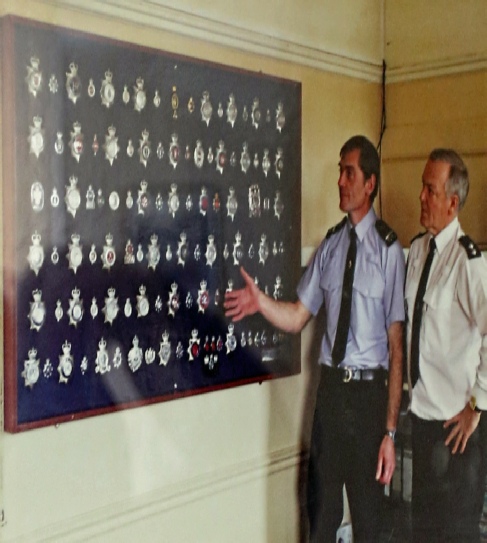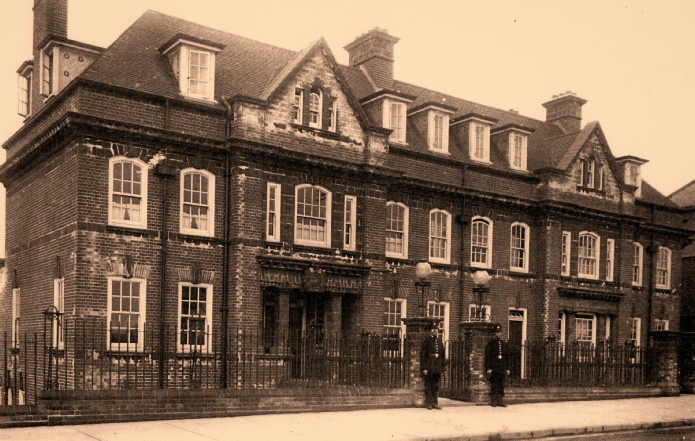
Harwich Police Station (Built 1915)
Article by Richard Kirton – 18th March 2014
Harwich Police Station is constructed of red brick and is similar but larger than the now closed Police Station in Rochford, Essex.
Architect for both buildings was Frank Whitmore. (more photographs…)
The town of Harwich is situated in the north east of Essex on the estuary of the rivers Stour and Orwell and has a rich maritime history boasting famous inhabitants such as Christopher Jones, master of the Mayflower and the diarist Samuel Pepys. The town of Harwich today is associated with Dovercourt and the two, along with Parkeston, are often referred to collectively as Harwich.
The importance of Harwich changed significantly with the arrival of the railway station in 1854 and later in 1883 when Parkeston Quay, now known as Harwich International Port, was opened. Probably it was the significance of the town to travellers and the increase in population which prompted the need to build such a substantial new Police Station complex. The site was designed as a self-contained law enforcement centre complete with court offices and accommodation for many police officers.
Plans for the proposed new Police Station were drawn up by the County Architect, Frank Whitmore in April 1913 and copies of some of the plans hang today on a wall within the building. This purpose built Police Station comprised of a basement, first and second floors and a roof space, referred to as the attic and part of this was as single Police Constables’ Quarters.
The Basement was divided up into various rooms to house the resources necessary to run such a large complex. These included a Weights & Measures Room, 2 Wash Houses complete with toilets, Store Rooms, and a Bicycle Store.
A block of terraced houses was created at the back and to the west of the Police Station which accommodated three married constables and one married sergeant. The accommodation was quite large, each house having a kitchen, pantry and living room on the first floor, two bedrooms on the second floor and a third bedroom in the attic of the roof space. The kitchens, living rooms and first two bedrooms were quite large, all measuring 13' 6" x 12' 0". This block of terraced houses exists today and the extract from Google Earth shows just how substantial the overall complex still is.
A detention room and four Prisoner Cells were constructed to very strict security guidelines. A Magistrates Court was built at the south end of the building but this was later demolished after being relocated within the Harwich Town Hall complex on the quay.
Gardens were created to the west of the main building along with a grass slope along the front of the building from the pavement down to the basement level.
A small footbridge, flanked by two pillars at the entrance and adorned by police beacons, crossed this slope from the pavement to the public entrance of the Police Station. A similar footbridge, flanked by just two pillars, connected the pavement to what used to be the Inspector’s accommodation to the north of the building.
The Sergeant’s accommodation was built adjacent to this with access via steps from the basement level at the front and rear. A fence was built along the South-east boundary of the site and walls were built along the North-west and South-west boundaries.
 One unique collection which has taken pride of place in the recreation room at Harwich Police Station is that of all 43 Police Force Helmet and Cap badges plus a few others such as Guernsey, Garda Siochana, Royal Docks and various Dock Police.
One unique collection which has taken pride of place in the recreation room at Harwich Police Station is that of all 43 Police Force Helmet and Cap badges plus a few others such as Guernsey, Garda Siochana, Royal Docks and various Dock Police.
It was the result of a year long project by 'Beat Supervisor' Keith Wall and the picture shows Keith officially handing over the collection to Inspector Peter Hudson in October, 1977. Most forces gave willingly to Keith but often more than a request to the clothing store was required. He spoke personally to a couple of Chief Constables who were most obliging: more so than some of the staff in stores around the country. Keith recalls how difficult Essex proved to be.
During the great flood of 1953 the entire basement suffered and the water reached the level of the round lamp above and to the right of the rightmost door on the west facing wall. Sergeant Dan Elford, the Contingency Planning Officer at that time, used the Essex Police ‘History Notebook Number 27’ to write an article about the floods titled ‘We are in for a high tide tonight’
Interestingly, Nicholas Kenneth Alston CBE, Police and Crime Commissioner for Essex Police was born at Harwich police station in 1952 and his father, Kenneth Alston, served in the Police Force for 37 years eventually rising to the rank of Deputy Chief Constable of Essex Police before retiring in 1971.
Looking east towards the rear of the building, the two integral police houses can be seen on the left with their individual rear access via steps. The Prisoner Cells and Detention block can be clearly seen to the right.
The basement with all of it’s supporting rooms are above ground and would have been completely flooded in 1953.
The front part of Attic in the Roof Space was also fully utilised.
The final photograph shows the building not long after it was built in 1915 with two constables posing outside each brick pillar each side of the pedestrian footbridge in front of the main entrance to the police station. You can clearly see the lamp of top of each pillar.

I would particularly like to thank Inspector Christopher Willis who kindly gave me his valuable time and personally showed me around Harwich Police Station.
I would also like to thank Detective Chief Inspector Richard Baxter who liaised on my behalf to seek permission to visit this lovely old building.



© 2015 - Richard Kirton - All Rights Reserved | Privacy Policy | Terms of Use | Site Map

